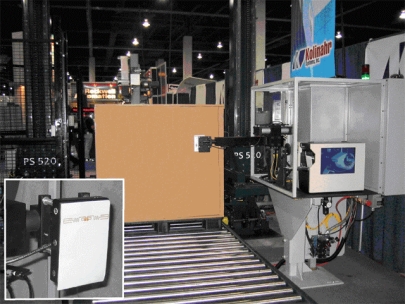A specialist in pallet labelers and stacking equipment recently introduced a new machine that applies RFID labels to pallets.
The new SA2200-RF Dual Panel RFID Pallet Labeler, manufactured by Kolinahr Systems of Cincinnati, uses a Zebra Technologies R110xiIIIPlus RFID-enabled printer-encoder to read, write, and verify the RFID tags embedded in the labels. For dual-sided applications, an RFID label can be applied to one side of a pallet and a label with just a bar code and human-readable text can be applied to a second side.
Manufacturers often use dual-sided pallet labeling because so many goods pass through third-party warehouses before reaching their final destination. Having labels on two sides of a pallet makes it easier to find a bar code to scan regardless of how the pallets are stacked in the third-party facility, according to Bill Walker, Kolinahr’s manager of marketing and sales. While it would seem superfluous to keep labeling two sides of a pallet when one of the labels has an embedded RFID tag, Walker says his company will continue to manufacture the double-labeler until their customers’ entire supply chains have made a complete transition to RFID.
A 3-inch-wide by 3-inch-thick rotating arm applies the label to the leading edge of the pallet load. For dual-sided pallet labeling, the RF label is pulled off a reel that alternates between labels that have an embedded RF tag and labels that will bear only a printed bar code. The machine then verifies the tag. If the RFID tag can’t be verified, it is automatically removed and another RFID label is applied, ensuring that no pallet leaves without a tag.
In spite of the importance of pallet labeling to the supply chain, interest in Kolinahr’s new product has been limited so far. With RFID tags still running between 40 cents and $1 apiece, compared with less than a nickel for a bar code label, the high-volume consumer products manufacturers that Kolinahr sees as its key market for the new machine have been slow to meet the RFID mandates of Wal-Mart and other retailers, according to Walker. “People are dragging their feet getting into this, pretty much,” Walker says. “It’s an additional expense for the manufacturer.’
Demand for the new RFID pallet labeler, which sells for $45,000 to $48,000 depending on the options package, has been strongest among manufacturers of high-value goods, such as Hewlett Packard, where value per pallet is highest, Walker says.
Walker expects that demand for RFID pallet labels—and his company’s RFID pallet labeler—will pick up toward the end of the year, when tag manufacturers are expected to introduce new tags based on EPCglobal’s Gen 2 standard. The new tags are supposed to be more robust than the current generation, he says, and should also become cheaper, thanks to increases in volume.
While the Zebra unit is currently set to read tags that comply with the EPCglobal Gen 1 standards, Walker says upgrading to the Gen 2 standard will consist of simple software upgrade to the unit’s ThingMagic reader module.
The new machine prints and encodes the RFID labels “a second or two” more slowly than it takes to print conventional bar code labels, but Walker says the difference has no impact on line speed because palletizing goods and shrink-wrapping the pallets can take up to a minute.
Instead of being sold a new RFID-enabled pallet labeler, current Kolinahr customers have been offered the option of adding RFID-labeling capabilities to the conventional Kolinahr pallet-labeling systems they already own. He says upgrades involve simply replacing the system’s bar code printer with an RFID label printer-encoder, making a few software changes, and adding the tag removal arm. However, no one has expressed an interest in the offer yet, he says. The firm has not set a price on the upgrade kit, but will set it when they hear from a customer, according to Walker. However, he says, “it’s going to be relatively cheap from a hardware standpoint.” Kolinahr’s conventional dual-sided bar code labeler is priced at $43,000, just $2,000 less than the new RFID labeler.
Aside from its Zebra printer, the SA2200-RF Dual Panel RFID Pallet Labeler has not changed very much from its prior conventional labeling version. Walker points to both the machine’s brain and brawn as reasons to choose it out of a market that may be attracting more entrants, such as Sato Deutschland (see Label Applicator Works on Pallets).
The system is operated by a programmable logic controller, which communicates with the palletizer and other packing-line equipment. At the same time, the SA2200-RF is a rugged unit.
“We have a huge steel-gusseted pedestal stand that the unit sits on,” says Walker. The printer itself is protected in a roofed cage and surrounded by an unbreakable Plexiglas-like material. Knocking it over would “take a tank hitting it almost,” he says.
“Compared to what’s out there, we are much more heavy-duty. I kind of hate to use that term because everybody does, but our unit was specifically designed for labeling pallet loads, and pallet loads are very unforgiving when they run into your machines,” he says.


